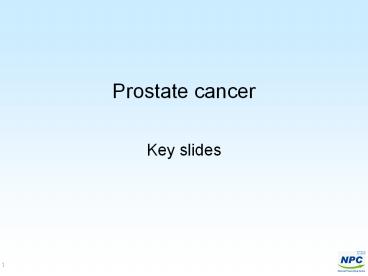Prostate cancer - PowerPoint PPT Presentation
1 / 10
Title:
Prostate cancer
Description:
Prostate cancer Key s Diseases of the prostate www.cancerscreening.nhs.uk/prostate Prostate cancer malignant growth of prostate cells, localised and may spread ... – PowerPoint PPT presentation
Number of Views:107
Avg rating:3.0/5.0
Title: Prostate cancer
1
Prostate cancer
- Key slides
2
Diseases of the prostatewww.cancerscreening.nhs.u
k/prostate
- Prostate cancer
- malignant growth of prostate cells, localised and
may spread - nearly all prostate cancers are adenocarcinomas,
mainly occurring in the peripheral zone of the
prostate gland - rare in men under 50, and is more common with
increasing age - Benign prostatic hyperplasia
- non-malignant increase in size of the prostate
with age - rare in men under 50
- Prostatitis
- inflammation of the prostate
- can occur in men of any age
The early symptoms of prostate diseases are very
similar
3
Clinical features of prostate cancerwww.cancerscr
eening.nhs.uk/prostate/prostate-booklet-text.pdf
- Prostate cancers (unlike BPH) tend to develop in
the outer part of the prostate gland - Unusual for early cancers to cause any symptoms
- Locally advanced prostate cancers that have
extended outside the capsule are also frequently
without symptoms - If the tumour is large enough, it can cause lower
urinary tract symptoms (LUTS) eg frequency,
urgency, hesitancy, leaking, but by the time this
happens the cancer will usually have reached an
advanced stage
- LUTS are similar to those of BPH. Most men with
LUTS will not have prostate cancer - Often the first sign of prostate cancer is
evidence of metastases (frequently in bone,
causing bone pain) - About 2030 of patients in the UK present with
metastatic disease
4
Overview Initial investigations
- Symptoms may occur only when the cancer is
advanced and may be similar to BPH - Offer a DRE and a PSA test after counselling to
patients with symptoms suggestive of prostate
cancer before referral to a specialist - There is no criterion for PSA level below which
men may be reassured that they do not have
prostate cancer, nor an agreed level that is
considered diagnostic - Transrectal ultrasound biopsy (TRUS) should be
offered after discussion of the likely risks and
benefits to the patient
5
www.nice.org.uk/CG58
TREATMENTS
Localised Watchful waiting Active
surveillance Radical prostatectomy External beam
radiotherapy Brachytherapy
Metastatic Orchidectomy or continuous
LHRHa Bicalutamide or androgen withdrawal Intermit
tent androgen withdrawal Hormone refractory
Docetaxel Corticosteroids Spinal MRI (spinal
metastases) Decompression of urinary tract
(obstructive uropathy) Palliative care
Managing side effects of treatment Erectile
dysfunction (PDE5 inhibitors first line) Urinary
incontinence refer for possible artificial
sphincter Side effects of hormonal treatments
?Hot flushes progestogens ?Gynaecomastia with
bicalutamide radiotherapy to breast buds (or
tamoxifen if fails) Painful bone metastases
strontium-89 or bisphosphonates
High Intensity Ultrasound or Cryotherapy Only as
part of a clinical trial
Localised advanced Neoadjuvant and concurrent
LHRHa with radiotherapy Adjuvant hormonal
therapy with radiotherapy Pelvic radiotherapy
6
Hormone therapy(androgen deprivation
therapy)EAU Guidelines 2005 NICE TA101 2006
Damber JE, Aus G. Lancet 200837117101721
- Prostate cells are physiologically dependent on
androgens (mainly testosterone) to stimulate
growth, function and proliferation - The testes are the source of 9095 of androgens
(510 from adrenal glands) - If prostate cells are deprived of androgenic
stimulation, they undergo apoptosis (programmed
cell death) - Any treatment that ultimately results in
suppression of androgen activity is called
androgen deprivation therapy (ADT) - Can be achieved by suppressing secretion of the
testicular androgens (castration, LHRH agonists),
by inhibiting the action of circulating androgens
(anti-androgens), or both (complete androgen
blockade)
7
Methods used for androgen depletionNICE.
Improving outcomes in urological cancers. 2002
8
NICE recommendations for managing the
complication of hormonal therapy NICE Clinical
Guideline and Full Guideline 582008
- Offer oral or synthetic progestogens for hot
flushes. Offer oral therapy for 2 weeks and
re-start when flushes recur, if effective - Offer prophylactic radiotherapy to breast buds
within the first 6 months of long-term (gt6
months) treatment with bicalutamide - Consider weekly tamoxifen if radiotherapy does
not prevent gynaecomastia - Do not routinely offer bisphosphonates to prevent
osteoporosis in men receiving androgen withdrawal - More research is needed into the prevention and
management of osteoporosis in men receiving
long-term withdrawal deprivation therapy (NICE)
9
Prescribing trends
10
Summary
- Prostate cancer is the most common cancer in men,
and is second only to lung cancer in terms of
cancer deaths - Unusual for early cancers to cause any symptoms
- Offer a DRE and a PSA test after counselling to
patients with symptoms suggestive of prostate
cancer before referral to a specialist - NICE guidance makes disease staging-based
treatment recommendations - Androgen deprivation therapy recommended for
locally advanced and metastatic disease

